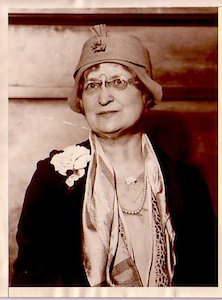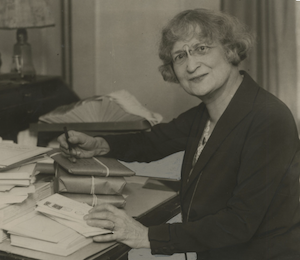
Mary Ware Dennett was born in April of 1872 in Worcester, Massachusetts. She was the first daughter and second oldest child in the family. In 1882, after the death of her father, she moved to stay with her mother’s relatives in Boston. It was there that Dennet was first introduced to social reform. Lucia Ames Mead, her aunt, was a strong advocate for women’s suffrage and promoted anti-war ideals. This influenced her to take an early interest in women’s independence and representation.

After completing secondary education, Dennet studied at the School of the Boston Museum of Fine Arts. There, she researched the design of leathers and tapestry. Being an advocate for economic and decorative independence and expression, she went on to become the Head of the Department of Design and Decoration at Drexel Institution. Following this, she started her own handicraft store and organized the Boston Society of Arts and Crafts. Moreover, in 1913, she co-founded the Twilight Sleep Association and the People’s Council of America in 1917. The Twilight Sleep Association worked to promote the practice of Twilight Sleep for women in labor. With this organization, women would be given anesthetics to go to sleep before giving birth, allowing for a less painful process for the mothers. The People’s Council of America advocated for the use of morphine and scopolamine as painkillers for women in labor and for pacifist socialism.
Dennet entered the Women’s Rights Movement in 1908, and she began serving as Field Secretary of the Massachusetts Woman Suffrage Association. In 1910, she was elected to be Corresponding Secretary of the National American Woman Suffrage Association (NAWSA) in New York, which led to her move there. She became NAWSA’s Principal Organizer for their literature department and published her first pamphlet, “The Real Point.” She worked all across the nation for an implementation of a single tax to shorten the large wage gap in the country, while also fighting for anti-war/militarism policies and international free trade.

Dennet’s fame grew in 1915 when she co-founded the National Birth Control League, which reorganized into the Voluntary Parenthood League. Her main efforts were put into promoting information regarding contraception and sexual education. She contributed to this directly by authoring the pamphlet, “The Sex Side of Life,” and distributing it widely. It spoke about the issues of current sex education materials, and rectified them by clearly labeling and explaining the role of sex organs. This work further explained sexually transmitted diseases and their cures, menstruation, and consent. Though all of these topics were considered to be openly spoken about, the pamphlet led to a great uproar. Eventually, this discomfort became a court case, and Dennett was convicted in 1928 for breaching the Comstock Act of 1873, which stated that it was illegal to mail “obscene, lewd or lascivious,” “immoral,” or “indecent” works.
However, this was not the end of Dennett's work. In 1930, she appealed the case to the United States Court of Appeals in New York, arguing that it was not intended to be “obscene” or “indecent” at all, merely educational. The verdict of the previous case was reversed, and led to a national emphasis of the idea that text cannot be considered “obscene” simply for discussing a quieted topic. She challenged society’s norm of hushing up topics and worked for the fair education of them, rather than promoting fear.
After this landmark case, Dennett stayed active in the National Council on Freedom from Censorship and the American Civil Liberties Union. After retirement, she returned to leather design and passed away in 1947 at the age of 75.
Why Did I Choose to Research Mary Ware Dennett?
I chose to research Mary Ware Dennett because she not only worked as an advocate for freedom in relationships and healthcare, but also as an educator. She believed strongly in topics such as easing the wage difference, the right to contraception, understanding of sexual relations, and created organizations to spread awareness of these subjects. Rather than falling into the societal norm of accepting fear, Dennett created change by sharing information, giving the facts so that people could make an educated decision. She truly changed the face of American media and societal discussion.
Works Cited
Burnette, Brandon R. Comstock Act of 1873, https://www.mtsu.edu/first-amendment/article/1038/comstock-act-of-1873.
Delora, Renee, and Sara Catherine Lichon. “Dennett, Mary Ware (1872-1947).” Jane Addams Digital Edition, https://digital.janeaddams.ramapo.edu/items/show/3822.
Heins, Marjorie. “A Birth-Control Crusader.” The Atlantic, Atlantic Media Company, 25 Sept. 2014, https://www.theatlantic.com/magazine/archive/1996/10/a-birth-control-crusader/376695/.
Malladi, Lakshmeeramya. “Mary Coffin Ware Dennett (1872-1947).” The Embryo Project Encyclopedia, 22 June 2016, https://embryo.asu.edu/pages/mary-coffin-ware-dennett-1872-1947.
Malladi, Lakshmeeramya. “The Sex Side of Life (1919) by Mary Ware Dennett.” The Embryo Project Encyclopedia, 27 May 2017, https://embryo.asu.edu/pages/sex-side-life-1919-mary-ware-dennett.
Malladi, Lakshmeeramya. “United States v. Dennett (1930).” The Embryo Project Encyclopedia, 23 June 2017, https://embryo.asu.edu/pages/united-states-v-dennett-1930..
Mary Ware Dennett Papers, 1874-1947; item description, dates. MC 392, folder #. Schlesinger Library, Radcliffe Institute, Harvard University, Cambridge, Mass. https://id.lib.harvard.edu/ead/sch00058/catalog. Accessed September 03, 2022.
This article was published on 1/30/23